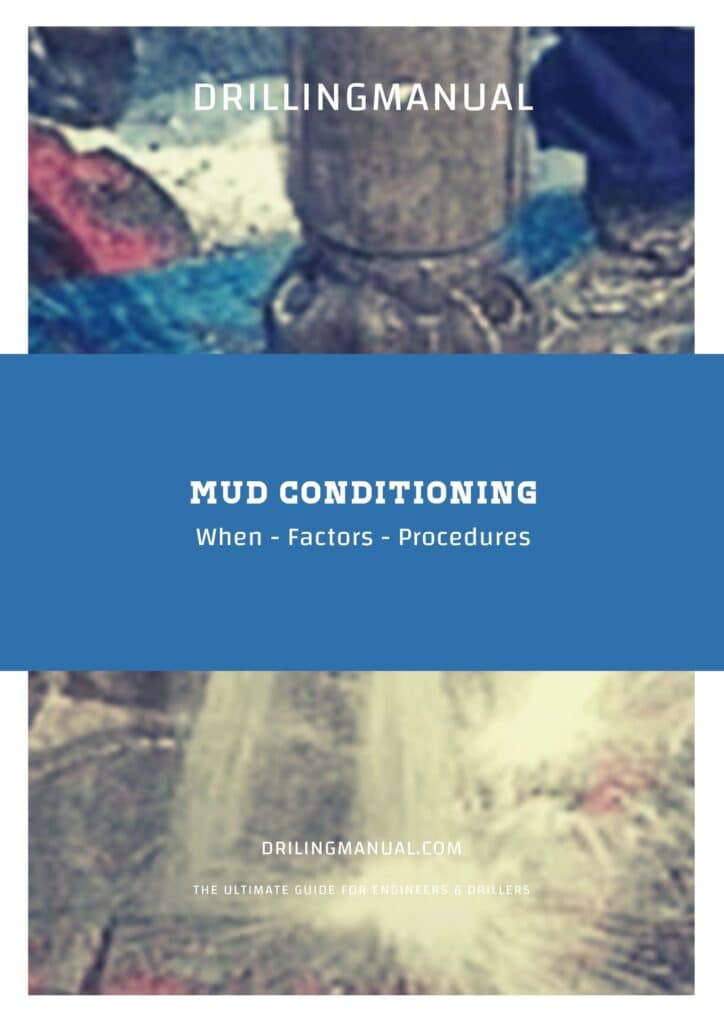Drilling muds are designed to facilitate drilling operations and provide proper cuttings transport. They are not necessarily conducive to efficient mud displacement, logging, or completion operations. Therefore, it is often necessary to condition the mud (i.e., to modify mud properties). Before placing cement (Cementing in drilling) in the wellbore, two mud characteristics can be changed—density and rheology. The required adjustments vary according to the particular situation.
Why Mud Conditioning Is Important?

It is generally desirable to reduce the mud density without compromising well control. Reducing the mud’s gel strength, yield stress, and plastic viscosity (Rheometer Test Method) is also beneficial. Doing so reduces the driving forces necessary to displace the mud and increases mud mobility. Of course, these steps require prior removal of the drilling cuttings from the borehole and the drilling fluid. When the cuttings are removed from the drilling fluid, its yield point usually decreases. One must be careful to prevent settling of weighting agents (e.g., barite in drilling mud); otherwise, control of mud density (mud balance) is lost. This may represent a major constraint for highly deviated holes (Crook et al., 1987) in terms of minimum values for the low-shear-rate rheology.
Next Stage
Once the mud is clean, its rheology can be further modified by adding dispersants, water, or base oil (which also reduces the density). It is necessary to circulate the mud until its rheological properties fall within the desired range.
This requires circulation for at least one hole volume, which ideally should be performed before removing the drill pipe. Otherwise, unconditioned mud may have sufficient time to gel while the crew is removing drill pipe, logging, and casing running.
Move Your String
Moving the drill string during conditioning aids the displacement of gelled mud and helps keep the cuttings suspended. High-speed pipe rotation is particularly beneficial in horizontal sections because of the orbital movement of the string, while in deviated sections, reciprocation allows the string to move up and down the hole (Al Khayyat et al., 1999; Section 5-2.4.4).
Running The Casing
The running of the casing should be performed carefully to avoid fracturing the formations. The equivalent flow rate in the annulus (q ann ) as a function of the speed at which the casing is run (v run ) is given by the following equation:
qannulus = vrun x Apipe
where Apipe = cross-sectional area of the pipe.
A quick calculation shows that these rates are not negligible. For example, a 7-in. outside diameter (OD) pipe run at 3 ft/s [1 m/s] gives rise to an annular flow rate of 8.6 bbl/min [23 L /s]. Because the casing is not run continuously, the velocity is not constant, and inertial forces also contribute to the annular pressure. Mathematical models for calculating the associated pressure surges can be found in the literature (Mitchell, 1988; Zamora et al., 2000).
Mud Conditioning After Casing
The mud should be circulated after the casing is in place, because the well may have been static for a long period, allowing the mud to gel or build a filter cake. The minimum circulation volume should be at least “bottoms up” (pumping one annular volume; the internal volume of the tubulars is ignored), and preferably greater. Mud circulation is also beneficial because it
- helps clean cuttings out of the hole
- ensures that gas flow is not occurring
- helps detect any gas flow into the well
- homogenizes the mud after treatment on the surface
- reduces the yield stress and plastic viscosity because most drilling muds are thixotropic (check also Thixotropic Cement)
- erodes the gelled or dehydrated mud that is trapped in washouts, on the narrow side of an eccentric annulus, and at the walls of permeable formations (because the shear stress exerted by the flowing mud is usually less than the shear strength of the mud film, this erosion is only possible if the hydraulic action of the fluid is supplemented by casing movement, especially when scratchers are installed on the casing).
Unfortunately, at this stage, operators commonly perform only mud conditioning.
If cuttings, or gelled or dehydrated mud, are scraped into the mud while running the casing, an excessive pressure buildup can occur when circulation is resumed. Therefore, it is often desirable to circulate the annulus at intermediate depths before the casing reaches the bottom of the hole.
These qualitative recommendations are only marginally helpful for the completion engineer, who must design the mud-circulation phases before removing the drill pipe and after the casing is in place. For a better understanding of the relative importance of each parameter, it is possible to use mathematical models that predict mud circulation. However, continuous monitoring of mud circulation remains the best method to verify adequate mud conditioning.
References:
- Well Cementing Second Edition Editors Erik B. Nelson and Dominique Guillot